June 2, 2006
Air Date: June 2, 2006
FULL SHOW
SEGMENTS
The View Today
/ Molly PetersonView the page for this story
As construction gets underway to repair the levees of New Orleans, much is being learned about what went wrong and what's to be improved for future hurricane protection in the city. Molly Peterson reports. (12:30)
A Checkered Past
/ Jeff YoungView the page for this story
How did New Orleans end up with such a flawed storm protection system? Living on Earth's Jeff Young traces the history of the region's levees and finds misplaced priorities, political squabbles and a coastline sinking around the rising floodwalls. (18:30)
Future Outlook
/ Steve CurwoodView the page for this story
There are a number of engineering plans on the drawing board that aim to give New Orleans and the Gulf Coast the level of protection they need to fend off hurricanes. Host Steve Curwood examines the feasibility, practicality, and cost to implement some of the major proposals. (17:10)
Show Credits and Funders
Show Transcript
HOST: Steve Curwood
REPORTERS: Molly Peterson and Jeff Young
[THEME MUSIC]
CURWOOD: From NPR, this is Living on Earth.
[THEME MUSIC]
CURWOOD: I’m Steve Curwood. As the new storm season begins, the faulty levee systems and eroded coastal wetlands have a long way to go before the people of New Orleans and Southern Louisiana can feel safe again after living through Hurricanes Katrina and Rita.
At least four different engineering teams still are trying to determine exactly why the levees failed and the best ways to make sure it doesn’t happen again. And out of the devastation there is a new determination that answers will be found.
DUFRECHOU: There’s a part of me, I guess, that stopped living on Aug 29 and another part that‘s still here. The part that’s still here is the part that knows we can change it, that we can make this community sustainable, and we can do it right. (recovers emotionally) Um, (sigh),. and dadgummit, we’re gonna do it.
CURWOOD: Storm protection – past, present, and future –this week on Living on Earth. Stick around.
[NPR NEWSCAST]
ANNOUNCER: Support for Living on Earth comes from the National Science Foundation and Stonyfield Farm.
[THEME MUSIC]
The View Today
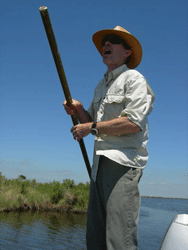
Darin Lee boats through what used to be the marshlands of his childhood, now mostly open water. (Photo: Molly Peterson)
CURWOOD: This is Living on Earth. I’m Steve Curwood, in New Orleans.
[MUSIC: Louis Armstrong “St. James Infirmary” from ‘Satch Blows the Blues’ (Sony –1929)]
CURWOOD: Those Blues, born along the Mississippi and jazzed up in New Orleans more than a century ago, still reflect the mood of this city in June of 2006. A new hurricane season is on, and Gulf Coast residents are still picking up the pieces from the last one.
Katrina surged through man-made channels and over open water last August 28, killing more than 1,300 people when the levees broke in several places - bringing about the largest civil engineering disaster in American history.

Darin Lee boats through what used to be the marshlands of his childhood, now mostly open water. (Photo: Molly Peterson)
Over the years, as the city sprawled out and coastal industry grew, man-made defenses became even more important. This week, we look at how the Gulf Coast has engineered protection against flooding and hurricanes – and we’ll examine ideas for shielding Gulf residents in the years ahead.
We begin with a look at the repairs still underway at the levees and the quest to find out what exactly caused their failures. Molly Peterson has our report.
[DRIVING ON GRAVEL, BOAT SPLOSHING SOUNDS]
PETERSON: Even during storm season, South Louisianans love to fish. Boat trailers pack the lot at Beson’s Launch, and among them this Saturday is Darin Lee. Lee is a coastal scientist for the state, and he points out the signature of last year’s hurricanes.
LEE: They’re called marsh balls in colloquial terms, these little chunks of marsh that have been thrown out into this eroded area, and now they’re beginning to die, barely sticking up out above the water, and that’s what you see from hurricane damage.
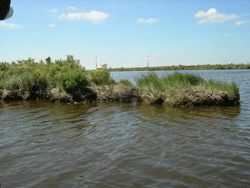
The last remnants of marshland jut out of the water, signaling a rapidly eroding area due to hurricane damage. (Photo: Molly Peterson)
LEE: Everyone understands that friction of this marsh basically reduces that flow of water and buffets that storm surge.
PETERSON: Like these wetlands, the manmade hurricane defenses that protect New Orleans are battered after last year’s storms. The Army Corps of Engineers has been rebuilding the city’s system of levees, dikes and canals, readying for storm season. Engineers and scientists have been trying to understand how mistakes people made are linked to catastrophic flooding – and how to prevent it again.
An Army Corps task force is conducting the official investigation. Co-director Reed Mosher says last year’s storms are teaching investigators more about the system than lab tests ever did.
MOSHER: We’re discovering some things that hadn’t been seen before. Now that’s not good that they’ve led to failures. That’s bad that they have led to failures. But from a science standpoint you do find things when you actually get loadings on them that you have not seen before.
PETERSON: And that new knowledge has made some repairs into improvements. One place the levee system failed early under the strain of the storm was at the Industrial Canal, a wide waterway on the East side of the city. Navigation channels further east funneled storm surge in from the ocean. That sent water over the top of the canal, carving trenches in the ground outside and weakening the walls.
These walls were concrete, surrounded by earthen hills. They tipped over and more water poured into neighborhoods filling streets to the roofs and rain gutters.
[CONSTRUCTION SOUNDS]
PETERSON: These walls are not coming back. Corp project leader, Chris Gilmore, says they are putting in something wider and stronger, called T-walls.
CHRIS GILMORE: Basically, what a T-wall is is like the letter T, but turned upside down. You have a base at the bottom in front and behind on the flood side, and the protected side, it just provides more support, more of a footprint for the wall itself.
[HOLLOW WIRE TENSION SOUND, DROP CONCRETE]
PETERSON: And along nearly 200 miles of the levee system, crews are adding what’s called scour protection – 8-foot wide beds of concrete – to shield against the force of water if storms surge over the top again.
[HOSE IN CONCRETE]
PETERSON: But it’s an incomplete fix. New concrete and T-walls on the east side of this channel are higher than those on the west. So if a storm surged in here again, the bowl of land on the New Orleans side would get wet first.
[SCRAPING SOUND, TROWEL ALONG SURFACE OF CONCRETE]
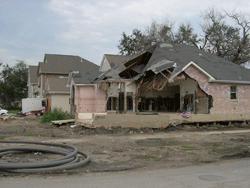
Houses in Lakeview, on the east side of the 17th Street Canal breach, sit wrecked and abandoned. (Photo: Molly Peterson)
Engineers are still working out the complicated story of what happened there. In Vicksburg, Mississippi, Army Corps researchers ran simulations to test how levee walls stood up to the energy of waves coming down the canal.
[SOUND OF WAVE GENERATOR]
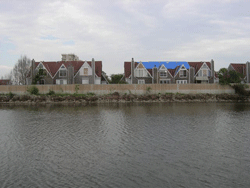
Houses in Orleans Parish sit right on the edge of the 17th Street Canal, as do trees and pools, which make levees less stable. (Photo: Molly Peterson)
[KEYS IN DOOR, FOOTSTEPS IN ECHOEY HALL, LIGHTS ON IN CENTERFUGE ROOM]
PETERSON: To test soils and sand under breach sites, engineer Michael Sharp and his team built models of walls and the sediments they sit on, in what look like fish tanks. Then they spin the models in a giant centrifuge, and flood them with water.
SHARP: And so then when we apply the load to it, weather that’s a flood load or a wind load, or an earthquake load then it will respond more like the actual field-size structure would.
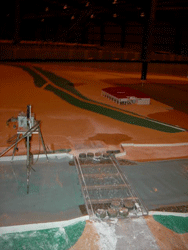
An Army Corps of Engineers task force is testing various factors that could have affected the performance of the levee system, using this 1:50 scale model of the 17th Street Canal and the New Orleans Lakefront. (Photo: Molly Peterson)
SHARP: Because it has a sand foundation. Whenever water can get to the sand then the pressure in the sand increases very rapidly, and that was a critical factor in the failure at London. The crack formed, the water could get down to the sand, the pressures of the water went very high and it basically just kind of lifted up the whole levee and lost all of its weight and its ability to resist any load. And it just kind of floated away.
PETERSON: At 17th Street there was also a layer of weak clay down below. Sharp believes that’s the reason the wall buckled and jumped 35 feet out from where it stood. There’s no agreement yet on the failure of these crucial canal walls. A team from UC Berkeley, funded also by the National Science Foundation, took its own soil samples at 17th Street, cores 20 to 40 feet deep. I caught up with UC Berkeley team leader Ray Seed as he was grabbing breakfast. He says his samples found something the Corps missed: runny material left behind by an earlier hurricane.
SEED: It’s hidden at the base of a whole mat of one-to-several inches of leaves and twigs and sticks that came down, probably during the same hurricane and mixed in with the layer. So it’s very difficult material to get a hold of.
PETERSON: Seed believes that unstable deposit is the reason the wall slid out like a greased pan. He says the Corps should do more sampling to make sure the same layer won’t fail again. Seed’s team is one of several doing separate investigations. Louisiana funded another, the National Academies of Science will make conclusions, too, and the Army Corps even has its own external review panel to double-check its work. Seed says the levees should be engineered to a level of risk 100 to 1000 times lower, more like dams.
SEED: The reason dams are treated so safely is because they threaten large populations when they fail. Current levee policies revolve in the 1930s and 1940s at a time when most levees in the United States protected cows and fields.
[17TH STREET CONSTRUCTION, BEEPING]
PETERSON: The Corps has been racing to finish one set of new projects aimed at upping the safety factor in New Orleans: it’s putting in gates at the top of the drainage canals where they connect with the lake.
[17TH STREET CONSTRUCTION, BEEPING]
PETERSON: During Katrina, water funneling in from the ocean came in through man-made channels and piled up in Lake Pontchartrain. Now Corps crews will block the water with long sheets of steel that cranes drop into the earth.
[SHEET PILE SLIDE…ABRUPT METAL SLIDING SOUND…METAL CHAINS CLANKING]
PETERSON: Crews vibrate the steel down into place. Tall enough to withstand waves and deep enough, engineers think, to stop water from seeping through sand underneath.
[SHEET PILE SLIDE AND VIBRATIONS, RAPID KNOCKING THAT COMES TO AN END]
PETERSON: It’s an engineering solution found commonly in the Netherlands, a country that’s battled storms and rising seas for a thousand years.
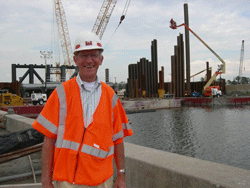
Dutch Engineer Jurjen Battjes says building gates to protect drainage canals in New Orleans from storm surges is only common sense -- he says the water is like an enemy, trying to invade your territory. (Photo: Molly Peterson)
PETERSON: That’s Jurjen Battjes. He’s a Dutch engineer, part of the panel reviewing the Army Corp’s work. He nods approvingly at the site. It reminds him of larger and more expensive projects the Dutch have built. Battjes says putting gates in here at 17th Street is only common sense.
BATTJES: The very first thing I asked, why are the pumping stations at the south end? And are these canals open? Because it’s so logical to keep the high water threat out of these canals by having a control gate at the lakeshore because it is relatively easy to close them off at the lake side.
PETERSON: Corps officials had planned to finish these temporary barriers by the first of June, but now they’re saying mid-summer. Corps project manager Chris Gilmore says there’s lots of reasons for the delay– everything from real estate access to wind blowing the sheets of steel around to materials they are finding at the site.
GILMORE: Right now there’s no telling what it’s going through in this area right here. I know when we first started driving it, it was having trouble going through woody debris, stumps and things like that. We’ve actually come in and excavated out to get below that.
PETERSON: Until engineers know more about the strength of the canal walls and until there is full pumping capacity again–the Corps and the city’s sewer board will have to keep careful watch on water levels.

Mary Ann Francois stands at the back of her property, where she noticed subsistence. Her house backs right up on the London Avenue Canal. (Photo: Molly Peterson)
FRANCOIS: Once you see something for a long time, it disappears. And that’s how I reacted to the floodwall behind me. I got so used to it being there. Until it started causing soil subsidence and things like that to the property, I just didn’t notice it, to be honest with you. And many trees and the shrubbery blocked the view.
PETERSON: But Francois did see her driveway cracking, the earth sinking, where water ponded. She didn’t wait for trucks from the local levee board. She brought in eight 12-foot dump trucks of dirt herself. Of course, it didn’t work. The ground is still sinking. And she says she doesn’t think she can risk living here again.
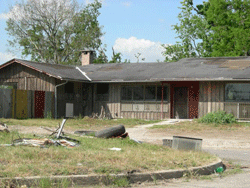
After Hurricane Katrina hit, the Cypress-framed home Mary Ann Francois lived in for 30 years was flooded with over eight feet of water. (Photo: Molly Peterson)
PETERSON: The Corps has been identifying more weak spots throughout the region that will need attention. It’s planning a map to tell people where the problems are. Until that’s ready, the hope this storm season is that residents, like the system’s architects, know more than they used to – and that they’re more on guard. For Living on Earth, I’m Molly Peterson in New Orleans.
CURWOOD: For more details on the levee failures, go to our website, loe.org. That’s loe.org.
Related links:
- U.S. Army Corps of Engineers Hurricane Recovery site
- New Orleans District Task Force
- Video of New Orleans Levee Model Illustrating IPET Preliminary Findings
- University of California at Berkeley press release of final report
[MUSIC: Louis Armstrong “St. James Infirmary” from ‘Satch Blows the Blues’ (Sony –1929)]
Coming up: we’ll look at the history and engineering decisions made long ago that led to the failure of the levees to protect new Orleans. Stay tuned to Living on Earth.
[MUSIC: Tuts Washington “Tee Nah Nah” from ‘Louisiana Spice’ (Rounder – 1995)]
A Checkered Past
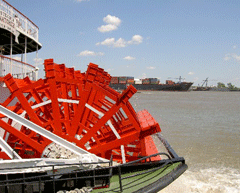
Rolling on the River: From sternwheelers to cargo ships, commerce on the Mississippi built New Orleans. The river also built all of southeast Louisiana's land. (Photo: Jeff Young)
CURWOOD: It’s Living on Earth, I’m Steve Curwood. By now it’s clear that Hurricane Katrina did not drown New Orleans by herself. The city flooded because its levees and floodwalls failed in the face of a challenge they should have contained.
Those walls against the water were tangible expressions of a community’s trust. People trusted their homes, belongings – their very lives – to a hurricane protection system that was 40 years in the making and then undone in a day.
Living on Earth’s Jeff Young reports on how that flawed levee system came about. It’s a history full of skewed priorities, political squabbles and unintended consequences for a river, the land it built, and the people who live on it.

Rolling on the River: From sternwheelers to cargo ships, commerce on the Mississippi built New Orleans. The river also built all of southeast Louisiana's land. (Photo: Jeff Young)
YOUNG: The Mississippi River built New Orleans.
[STERNWHEELER WHISTLE BLOWS, MORE CHURNING WATER]
YOUNG: From sternwheelers like this one to today’s ocean going vessels, commerce on the river made New Orleans one of the country’s busiest ports. But the river built this city in a more literal sense: it actually made all this land.
REED: Oh yeah, the whole of southeast Louisiana was built by the river.
YOUNG: Wetlands ecologist Denise Reed sits by the river across town from where she teaches at the University of New Orleans. Reed explains how for millennia the Mississippi picked up sediment from its enormous drainage and left it here.
REED: About every one thousand years or so, we think, the river built land in one area, then another, then another. And by the time we stopped it doing that it was going down the location that it presently does through the city of New Orleans. And so we’ve locked it into position now. It doesn’t swing around the coast like a hose pipe building land. When we did that, when we contained the river and tamed it within the levees, there were some unintended consequences.
YOUNG: River delta land is soft and loose and compacts over time. Without more sediment from river floods, the land sinks. And in the past 60 years or so, the marshes have been carved up with canals – thousands of them – for navigation and for the many oil and gas wells and pipelines. That let salt water from the Gulf of Mexico rush in, killing fresh water marsh.
REED: What it means is that we’re sitting on the delta of the sixth largest river in the world and it’s in fundamental decline. Much of the marsh and wetland that we have lost during the 20th century…it’s difficult to envisage how we could get that back. The system is so seriously deteriorated. Some parts of the coast are just not there anymore.
YOUNG: The city sank, and the coast shrank. In an average year Louisiana loses 24 square miles to open water. By 2050 it could lose another 500. That land sheltered migrating birds and one of the country’s richest fisheries. It was also south Louisiana’s buffer against storms raging in from the Gulf of Mexico. But then, people had a pretty good reason to build levees along the river.
[ARCHIVE SOUND NEWSREEL]
NARRATOR: …1927 brought havoc to Mississippi as torrents of water poured through the lowland states from Illinois to the Gulf…
[NEWSREEL DRAMATIC MUSIC UNDER]
BARRY: The river was this enormous force. That flood hit the homes of nearly 1 percent of entire population of the country.
YOUNG: Historian and New Orleanian John Barry. His book, Rising Tide, tells how the great flood of 1927 changed the region and its relationship with the river.
BARRY: They strengthened the levees significantly after the ’27 flood. They have not had a major flood break those levees since 1927.
YOUNG: Controlling the Mississippi became the top job for the Army Corps of Engineers. University of Maryland engineering professor and retired General Gerald Galloway knows how big a job that was. He served 38 years in the Corp.
GALLOWAY: The Mississippi was the big tiger that they were wrestling with. That’s the front door to New Orleans. The back door was the coastal protection from hurricanes. In 1965 Hurricane Betsy alerted everybody to the fact that you could put New Orleans under water from the back door.
[JOHNSON LIBRARY ARCHIVE TAPE]
LBJ: Is your home under water?
WM: Oh yes, water. About three feet to the house.
LBJ: What's happened to your neighbors?
WM: Well they the same way. They're the same way, sir.
YOUNG: President Lyndon Johnson comforted storm survivors just after Hurricane Betsy took that “back door” into the city. Water roared up an inland bay called Lake Borgne. From there it spilled into the city’s east via a canal just completed that year, called the Mississippi River Gulf Outlet. Water also swamped the city’s north from Lake Pontchartrain. Johnson pledged federal help.
[LBJ ARCHIVE TAPE]
LBJ: This state will build its way out of its sorrow. And the national government will be at Louisiana's side to help it every step of the way in every way that we can.
[APPLAUSE]
YOUNG: Hurricane Betsy spurred Congress to fund the first Army Corps plan to protect New Orleans from storms. That started 40 years of work on the 125-mile levee system – a system still not finished today. The original plan also called for more: a large storm surge barrier. When open, it would allow boats and normal tidal flow between Lakes Borgne and Pontchartrain. When closed, it would keep storm waters from surging into Pontchartrain and the city’s north. But that plan ran into a different kind of storm. Again, Gerald Galloway:
GALLOWAY: From the very beginning the construction of the hurricane protection system around New Orleans was fraught with lots of challenges.
YOUNG: The first was a lawsuit challenging the surge barrier. Communities on the lake’s north shore worried it put them in greater danger. And environmentalists argued it would damage the lake ecosystem. A federal judge agreed and sent the surge barrier back to the drawing board in the 70s. Vald Heiberg was district chief of the Corps at the time.
HEIBERG: We, the Corps of Engineers, never got beyond that point. I ended up being the head of the Corps and was the guy a decade later who said, ‘okay, we’re just gonna quit trying. We’ll just try to build those levees in New Orleans higher.’ I don’t know if that was the right idea. As I’ve told some people, that might have been the worst thing I ever did as chief of engineers.
YOUNG: After Katrina, the idea of surge barriers is back and still controversial. A recent report from the Government Accountability Office says it’s likely Katrina’s surge would have overtopped the barrier as it was originally designed. That could have made flooding even worse, because the original plan called for lower levees around the city.
But Heiberg and other former high-ranking Corps members insist New Orleans needs a surge barrier. They say a new design coupled with higher levees could protect against storms without harming the environment.
In any event, when the surge barrier plan died in the 70s, the Corps had to rethink its protection for New Orleans. They shifted focus to the city itself and three major weak points: the canals that carry rain water out to the lake could also let storm surge into the very heart of the city.
BARRY: You know, when you take on your enemy you generally don’t want to invite the enemy into your living room for the battle. And that’s essentially what happened.
YOUNG: Historian John Barry says the Corps proposed decades ago to put gates where each canal meets the lake – so canals made to drain out didn’t instead allow lake water in - very much like the ones they’re racing to build today. But politics intervened.
BARRY: The local politicians ordered the Corps, through legislation, not to do that because they felt it was too expensive. They didn’t want to pay their share.
YOUNG: With no surge barrier on the lake and no gates on the canals, the only plan left was to simply line the canals with higher levees and walls – levees and walls that fell when Katrina took the same back door to New Orleans that Betsy found open 40 years before. Barry says there’s plenty of blame to go around. But he places most of it squarely on the Army Corps.
BARRY: When the Corps looks at itself in the mirror I think there are some real problems here. There were many compromises that the Corp made. A lot of those compromises were forced upon it, but not all of them. Yeah, I’m pretty disappointed in the work they did.
YOUNG: Of course that levee work is now the focus of intense scrutiny. But Retired Corps General Gerald Galloway says the problems really started before the work began.
GALLOWAY: I would argue that the problem began when we failed to specify the level of protection to be provided.
YOUNG: All along, the Corps’ plan to protect New Orleans was based on a late ‘50s study by the weather service guessing the strength of storms most likely to hit. It was called the standard project hurricane.
GALLOWAY: When we picked the standard project hurricane for New Orleans we were picking low, not high. We went in the wrong direction. Instead of taking the biggest storm that we could conjure we took a sort of moderate storm. And as we’ve seen the results were disastrous.
YOUNG: The Corps upgraded its storm calculations with a study in the late ‘70s. Louisiana State University Hurricane Center Director Ivor Van Heerden says the Army even issued a directive in 1981 to use those new findings and design protection for a stronger storm.
VAN HEERDEN: Unfortunately the Corps seems to have stayed with the 1959 definition of a standard project hurricane, which was a much, much weaker storm.
YOUNG: They paid for this study. Why didn’t they use it?
VAN HEERDEN: We see cost cutting efforts one after the other. And we see this term in the internal correspondence – about this will cut costs, this will cut costs. So it looks like, perhaps, that the use of a weaker hurricane meant you didn’t have to build levees as robust or as high and as a result you cut your costs.
YOUNG: So was the problem a shortage of money? The storm protection system was still not complete when Katrina hit. And the Bush administration had cut maintenance budgets for levees. But still, Louisiana got more money for Corps projects over the past five years than any other state – nearly two billion dollars.
Steve Ellis is with the budget watchdog group Taxpayers for Common Sense.
ELLIS: So it wasn’t that we didn’t spend enough money; it was going to the wrong things. Rather than concentrating our resources and maintaining what we had, and trying to actually provide adequate or better flood protection, we were building other things across the state.
YOUNG: Ellis says Corps projects too often waste money and hurt the environment. The Corps says it’s changed to make restoration a major part of its mission. Two Corps projects just a few miles apart provide evidence for both arguments: the Mississippi River Gulf Outlet and the Caernarvan diversion.
[OUTDOORS ON CAERNARVAN LEVEE]
YOUNG: So, I’m walking along the Mississippi River levee downstream of New Orleans at a big bend in the river called English Turn in Saint Bernard’s Parish. There’s a little community called Caernarvan. Now Caernarvan is locally infamous in history, because in 1927, during the Great Flood, the powers that be that ran New Orleans dynamited the levee, right here.
Well it’s one of those funny coincidences of history that if you visit Caernarvan these days you’ll find there’s another intentional hole in the levee. Listen, you can hear some of the Mississippi River rushing through the levee. This time the goal is to use that water to save some of the disappearing wetlands.
VILLARUBIA: This is right near the spot where the levee was blown up. And so we’re trying to replicate that, albeit in a much in a smaller way.
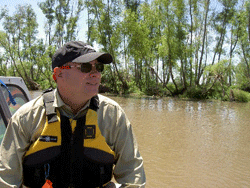
A River Runs Through It: Biologist Chuck Villarubia checks the flow at the Caernarvan freshwater diversion. The willows behind him have grown where there was once open saltwater. (Photo: Jeff Young)
VILLARUBIA: What we have is a series of five tubes that are 15 by 15 feet. That then distributes water from the river into the marsh. What this does is help simulate the over-bank flooding that happened before the levees were here.
YOUNG: And are we gonna open the gates here?
VILLARUBIA: Yeah, we can open the gates and show ya how it works.
[SOUND OF RUSHING WATER]
YOUNG: With the gates fully open, 8,000 cubic feet per second of muddy Mississippi rush through. In some parts of the country that would be a river itself. But it’s spare change here.
[WATER SOUND, THEN SOUND OF BIRDS, A LITTLE WIND]
YOUNG: The river water pushes back saltwater from some abandoned fields. Now the marsh is starting to come back, as is wildlife.
VILLARUBIA: Yeah, that’s him right now. There’s an alligator – that’s a half way decent sized one – kind of checking us out a little bit.
YOUNG: The concern about losing wetlands and the land its self is so great, it must be really satisfying to come here and say, ‘We’re starting to turn the tide,’ at least a little.
VILLARUBIA: Caernarvan has been successful. It’s been nice to see it work. And particularly now, after the hurricane, we’ve seen that, and we know that we need to have this marsh in front of the levees to make them more effective. Most of the levees look fine here, at least in this area. So we need to make this wetland restoration work along with levees for the protection of the whole area.
YOUNG: But any excitement over the success of this small project is tempered by hard lessons from its history.
YOUNG: The Corps proposed this diversion in the 60s but didn’t get it built until the 90s. Once built, it was nearly derailed by a billion-dollar lawsuit from oystermen who claimed the incoming freshwater damaged oyster beds. And while the corps spent $26 million at Caernarvan to help repair wetlands, it spent many times that on another project which destroys wetlands: the Mississippi River Gulf Outlet.
DUFRECHOU: The gulf outlet, in my opinion, has been a cancer.
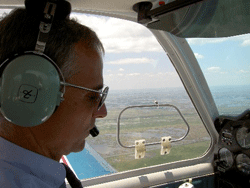
"Mr. Go has got to go.": Carlton Dufrechou flies over the project Louisianans love to hate: the Mississippi River Gulf Outlet (MRGO), known locally as Mr. Go. (Photo: Jeff Young)
DUFRECHOU: It bisected the coast. So it was a shortcut for salt water, the higher salinity waters of the gulf into the historically brackish or sometimes fresh water of the upper reaches, closer to New Orleans, eating away at our natural lines of defense down there, day in and day out.
YOUNG: Dufrechou says the best way to see all this is from the air.
DUFRECHOU: Clear prop!
[AIRPLANE ENGINE STARTS UP]
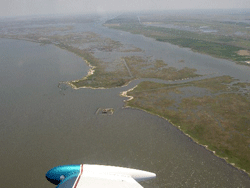
Past as Watery Prelude: Land loss left the old Martello Castle with nothing but walls against the water. Will New Orleans wind up the same way? (Photo: Jeff Young)
DUFRECHOU: And here we go.
YOUNG: When the Corps first dug the MRGO it was about 700 feet at its widest. But the soft banks eroded with each dredging, and salt water intruded. Over the decades it spread to more than 2,000 feet wide, destroying at least 27,000 acres of wetlands.
DUFRECHOU (ON HEADSET): Okay, so that channel right there is the Mississippi River Gulf Outlet. You get an appreciation of how much it’s opened up.
YOUNG: To the south of the MRGO we see the many repair jobs where the channel’s levee breached during Katrina, wiping out communities in St Bernard’s Parish. To its north, what’s left of the marshland looks to be melting away into Lake Borgne. Dufrechou points to an odd rectangle of stone in the shining water.
DUFRECHOU (ON HEADSET): Right down here, that thing in the water, that used to be a fort. And that used to be land around it. Used to be land you could walk to.
YOUNG: Wow.
DUFRECHOU: Now you have to take a boat to it.
YOUNG: The fort’s thick rock walls protected it since before the Civil War. But walls were no match for rising water and sinking land. It’s like looking at a possible future New Orleans – a walled island naked against the advancing water.
DUFRECHOU (ON HEADSET): That’s our first line of defense. Without the coast we can build levees as high as pyramids and we’re setting ourselves up for failure.
[PLANE SOUND FADES]
YOUNG: For Dufrechou the MRGO sums up all that is wrong with the way local officials, congress, and the Army Corp have engineered this coast. He sees misplaced priorities and little coordination of projects for navigation and storm protection. And he sees a damaging channel kept open year after year using up tens of millions of dollars that could have gone toward protecting the city and restoring the coast.
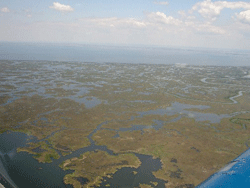
Bye-bye Bayou? Conservationists say the Mississippi River Gulf Outlet is hastening the demise of these wetlands, leaving New Orleans without its natural buffer against hurricanes. (Photo: Jeff Young)
YOUNG: Still not easy to talk about this, huh?
DUFRECHOU: (very emotional, fragile voice) There’s a part of me that stopped living on Aug 29 and another part that‘s still here. The part that’s still here is the part that knows we can change it, that we can make this community sustainable, and we can do it right. (recovers emotionally) um, (sigh) and dadgummit, we’re gonna do it.
YOUNG: Emotion still rides just under the surface here. A conversation can veer from hope to despair and back again. The storm made the mistakes of the past painfully clear. But it also strengthened those who would correct them. For Living on Earth, I’m Jeff Young in New Orleans.
Related links:
- John Barry’s book “Rising Tide:The Great Mississippi Flood of 1927 and How it Changed America”
- U.S. Army Corps of Engineers Improvements to New Orleans’ Hurricane Protection System
- University of Maryland – Working Group for Post-Hurricane Planning for the Louisiana Coast
- U.S. Government Accountability Office report on Hurricane Protection System
- Action Group dedicated to closing Mississippi River Gulf Outlet
[MUSIC: Lucinda Williams “Lake Charles” from ‘Car Wheels On A Gravel Road’ (UMG Recordings - 1998)]
CURWOOD: Just ahead: we meet some folks with big ideas about how to protect New Orleans and Southern Louisiana from future storms. Keep listening to Living on Earth.
ANNOUNCER: Support for N-P-R comes from N-P-R stations, and: Kashi, whose “Day of Change” tour features yoga lessons, natural food cooking demos, and Kashi cereals, crackers and granola bars. Details at Kashi dot com; The Kresge Foundation, investing in nonprofits to help them catalyze growth, connect to stakeholders, and challenge greater support. On the web at Kresge dot org; and, The Kellogg Foundation, helping people help themselves by investing in individuals, their families, and their communities. On the web at w-k-k-f dot org. This is N-P-R -- National Public Radio.
[MUSIC: Peter Case “When The Catfish Is In Bloom” from ‘I Am The Resurrection: A Tribute To John Fahey’ (Vanguard - 2006)]
Future Outlook

Ivor van Heerden, deputy director of the Louisiana State University Hurricane Center, at the helm of his sailboat, “The Magnum.” (Photo: Steve Curwood)
CURWOOD: It’s Living on Earth, I’m Steve Curwood in New Orleans.
[SOUND OF CONSTRUCTION VEHICLES]
Here at the 17th street canal – where raging storm waters broke through the levee and ravaged a neighborhood – workers race against time to build a flood gate and complete repairs on the dyke as a new hurricane season begins.

Ivor van Heerden, deputy director of the Louisiana State University Hurricane Center, at the helm of his sailboat, “The Magnum.” (Photo: Steve Curwood)
VAN HEERDEN: The barrier islands protect the wetlands. The wetlands protect the levees. The levees protect the home.
CURWOOD: Ivor van Heerden is deputy director of the LSU Hurricane Center and author of the new book, “The Storm: What Went Wrong and Why during Hurricane Katrina.” He hails from South Africa and brings with him international expertise on coastal restoration, along with the perspective of an outsider not so mired in local politics and turf wars.
In the cockpit of his sailboat, “The Magnum.” van Heerden quickly lays out the foundation of what it would take to rebuild the Gulf coast in a comprehensive way that would insure its protection.
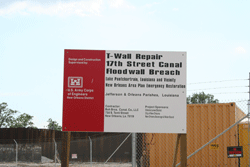
A billboard stands at the border of the massive reconstruction project headed by the U.S. Army Corps of Engineers. (Photo: Steve Curwood)
CURWOOD: Why are wetlands important for protection against hurricanes in New Orleans?
VAN HEERDEN: What we know is that a wetland reduces the storm surge because of the frictional effects as the surge moves through it. This is especially true when the surge is going through a Cyprus swamp because now you have trees that are at least 60 feet high, very well rooted, very well packed. So you imagine trying to push water through that forest, it slows down dramatically.
The second thing is as a hurricane approaches the coast, the right-hand side the winds are blowing to the shore, the left-hand side the winds are blowing out to sea. And so on the left-hand side you actually lower the water level so the plants and levees and the barrier islands stick up into the wind field, and as a consequence they take some of the energy out of the wind field. So the wetlands have two very important roles to play.
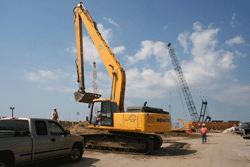
A construction crew erects new floodgates at the 17th St. Canal. (Photo: Steve Curwood)
VAN HEERDEN: The reason we’ve lost as many wetlands as we have reflects the fact that we’ve cut off the sediment supply from the Mississippi River, because of the artificial levees. All that sediment now goes into Gulf waters about 400 foot deep. And in addition we’ve crisscrossed all the wetlands with numerous canals and channels, some for navigation, some for oil and gas, and they’ve totally disrupted the natural function of many of those wetlands.
CURWOOD: How difficult is it to engineer the coastal restoration and the buildup of barrier islands?
VAN HEERDEN: In terms of the barrier islands, all that we need to do is move the sand from offshore about 11 miles, and then you can build up your barrier islands. There are many, many different systems. We’ve perfected beach restoration in the United States; it’s exactly the same technique.
In terms of the wetlands, we know from other examples we have in the central part of the coast that if you can just get the Mississippi water to the wetlands you’ll build little deltas, you’ll rebuild the wetlands and the whole area will rejuvenate.

Bayou LaForche, once a major branch of the Mississippi River, would get much more water under plans to restore the delta. (Photo: Steve Curwood)
He heads the coastal engineering division for the Department of Natural Resources and I met him on top of a levee in Donaldsonville, a small town on the Mississippi where both the demise of the wetlands began, but also where they may be reborn.
In 1904, the Mississippi was damned off from the head of the Bayou LaForche, a waterway that sits just a few hundred yards from this levee. The diversion cut off fresh water, nutrients and sediment needed for the healthy survival of the estuaries systems downstream on the Gulf of Mexico, the areas experiencing the greatest rate of wetland loss.
One plan calls for a break in the levee a few miles south of where we stand. Over time this major diversion would create a new river and form a new delta. But Bob Roberts says time is running out.
ROBERTS: What we’re finding out with that is it’s a long-term project. It’s on a scale that we need but in order to get it done it would take approximately 40 to 60 years for our channel to be capable of carrying the amount of water needed to build the delta, and to build delta at a rate that will help offset the loss rate that’s going on in the basins right now. And that’s what our work is showing us.
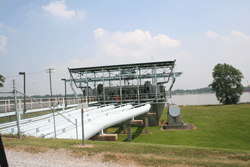
The existing pumping station at Bayou LaForche. Plans are underway to build a much larger one along this levee. (Photo: Steve Curwood)
ROBERTS: It’s not a land building project, it’s mainly a freshwater and nutrient project. We don’t have the flow capacity within the bayou anymore to carry sediments long distance. But we can get the fresh water where we need it to literally keep salt water at bay and give the fresh water marsh a chance, instead of converting to a saltwater marsh or converting to open waters as a whole. The nutrients also help fertilize that marsh so that it stays healthy.
CURWOOD: But without sand and sediment there’s nothing for the water to replenish. No place to anchor the kinds of vegetation needed to dampen storm surges. That’s where Kerry St. Pe comes in.

Kerry St. Pe explores the various species able to hold the wetlands in place and survive in the face of hurricanes, including a hearty variety of oak tree. (Photo: Steve Curwood)
ST. PE: Most of these are endangered birds that are flying over head. As you can see it’s heavily used by birds for nesting.
CURWOOD: Kerry St. Pe, who heads the Barataria-Terrebone National Estuary Program, leads me across acres of marsh, carefully pointing out the well-camouflaged eggs of nesting birds, coyotes tracks and sprawling vegetation, as a bevy of willets, least terns, and Wilson’s plovers swirl overhead.
With butterflies lazily floating among flowering bushes and plants, it’s hard to imagine that two major hurricanes, Katrina and Rita, roared through here just several months ago. St. Pe and his partner, Dean Blanchard, take me to the top of an eight foot high ridge, a ridge that, just five years ago, didn’t exist.

Bayou LaForche, once a major branch of the Mississippi River, would get much more water under plans to restore the delta. (Photo: Steve Curwood)
CURWOOD: Using a system of pipes and hydraulic pumps, the St. Pe team scooped up sediments from a dredging operation at nearby Port Fourchon and piled them up where the old photos showed them to be. Then teams went in to plant a variety of grasses, shrubs and trees, looking for species that can flourish in the harsh environment.
[FOOTSTEPS]
St. PE: We always get our picture with Dean next to this tree. That’s how we can show it from year to year, how it’s changed. This one actually had acorns on it. It was stressed pretty badly. It was totally brown after Rita. But you can see there’s a lot of new growth. It’s doing quite well, it’s gonna come back.
CURWOOD: Acorns out here where there used to just be water?
ST. PE: Yes.
CURWOOD: Now you have trees.
St. PE: Now we have trees. That’s the whole idea – building land out of open water. That’s what we need to do in Louisiana on a large scale, quickly.
CURWOOD: So you have a plan to take what you have modeled here and turn this into thousands of acres here in the Mississippi delta area. How’re you going to do this?
ST. PE: Well, we would build a system of hopefully permanent pipelines that would radiate from the Mississippi River from places of deposition, from point bars. You would harvest sediments, use what you can from that site, and move to another site, allowing the other spot in the river that you just harvested to repopulate or resettle sediments. We would look at the offshore sources where, as we’re standing here, we’re within a mile of the Gulf of Mexico. There are sediment sand deposits in the Gulf of Mexico that we could use, and we would use that to build our barrier islands, for example.
CURWOOD: There’s a saying around here, what, Louisianans know how to do best, that is.
ST. PE: Well we’ve certainly laid down a few pipelines in Louisiana, and of course that’s to transport petroleum largely. And let me just point out that when we initially brought this up we were told that we didn’t…the technology to pump great distances really didn’t exist. And my response was, well, gee, you know, we’re pumping a substance of similar thickness and viscosity all over the United States, and we call that oil. Certainly we can pump a solution of muddy water, you know, 40 or 50 miles without any problems.
CURWOOD: There are folks who say "Hey, wait a second, why not have Mother Nature do this? Help her a little bit by making another diversion of the Mississippi, a grand diversion, a third diversion which would slow the Mississippi down and the sediment would naturally come out into these areas and create these wetlands without this high-tech approach of having to build a big super pipeline or sets of pipelines?"
ST. PE: Well there has been examinations of a major new diversion from the Mississippi River. And so far the data that has come out of these studies and evaluations indicates that it would take 60 years before we actually start transporting sediments here. We clearly do not have 60 years. In the short term this pipeline thing is the only way that we can strategically build land exactly where we need it. It is the only way unless someone can point to something that we have not thought of, that no one has thought of. It is the only way that we can build land in the short term.
CURWOOD: If Kerry St. Pe is right – and he has hard ground to prove his point – it could be possible to pipe in enough sediment to make a major difference on the Louisiana coast. But it will be an uphill battle. With global warming, sea levels are projected to rise faster than they have in recent years, and the rate of increase may be dramatic. Again, Ivor van Heerden of the LSU Hurricane Center.
VAN HEERDEN: Louisiana’s been subsiding since time began. So sea level’s been rising for a long, long time, we’ve always managed to deal with it. We just gotta get smart. We gotta recognize that if we build the right levee systems, get the wetlands healthy and get them starting to procreate again, and rebuild the barrier islands, that we can come up with a system that, like the Dutch, could give us one in 10,000 years protection.
The other important thing is New Orleans is the testing ground for the rest of the coastal United States. You know, as sea level rises it’s not just going to be New Orleans that’s gonna have a problem – it’s gonna be Tampa, Long Island, maybe parts of New York, Houston, Galveston, Port Arthur, Texas. All these areas that could in due course have to build their own levee system.
CURWOOD: From what you understand, what’s necessary to put a system in the Gulf Coast region around New Orleans that would provide as much protection as the Dutch 10,000 year system?
VAN HEERDEN: All it requires is the willpower to do it. The United States is a very, very rich country. We’re talking about to get all of coastal Louisiana the so-called Category 5 protection, and rebuild all the wetlands and the barrier islands so we keep the productive fishery going, we keep the oil and gas infrastructure safe – we’re talking about $30 billion. Katrina was a $300 billion disaster. So, you know, it’s almost just a few cents on the dollar really to get the protection we need.
CURWOOD: Now some people say that over the long haul people need to think about giving much of the south coast of Louisiana back to the ocean. Retreating in from where people are now today. What kind of sense does that make to you, if any?
VAN HEERDEN: Well the plan I was outlining does require some retreat from the coast. Because right now if you look at coastal Louisiana, and imagine you spread the fingers of your hand in front of you, our levee systems kind of run along the outside of your fingers. And between each finger you have a “V,” and that’s basically a funnel that a surge can funnel up when we get a big storm. So really what we need to do in terms of that finger is to cut it off at the knuckles and have one line of levees. It’s much shorter in the long run but it runs across the central part of the coastal zone. Those areas that are outside, you have to compensate the people and give them locations inside the protected system.
CURWOOD: How many people right now live outside the protected system you’re talking about?
VAN HEERDEN: It probably amounts to maybe 100,000 at the most. The bottom line in all of this is as you plan it has to be a case of not what’s good for me, but what’s good for everybody. What makes the best sense for the overall population in coastal Louisiana.
CURWOOD: In the months and years ahead that will be the central question Louisianans and the rest of the nation must grapple with. And the merits of the civil and social engineering plans to protect New Orleans and its surrounding coastline will be hotly debated. This question about coastal protection has been going on for decades, at local, state and federal levels, with many proposals but not much action to address future storms.
But Katrina and Rita brought one unwelcome answer for civil engineers and politicians alike. To do nothing, to reach no consensus, to make no decision…is in fact a decision. One that will continue to leave the region vulnerable to the ferocious storms that push in from the Gulf of Mexico.
Related links:
- Louisiana State University Hurricane Center
- Ivor van Heerden’s book “The Storm: What Went Wrong and Why During Hurricane Katrina”
- LSU Center for the Study of Public Health Impacts of Hurricanes
- Louisiana Department of Natural Resources
- Barataria-Terrebonne National Estuary Program
[MUSIC: Bessie Smith “Backwater Blues” from ‘The Essential Bessie Smith’ (Sony – 1934)]
CURWOOD: Our program is produced by the World Media Foundation at the Jennifer and Ted Stanley studios in Somerville, Massachusetts. Chris Ballman produced and Ingrid Lobet edited our Gulf Coast special. Our researcher is Emily Taylor and our technical director is Dennis Foley. Alison Lirish Dean composed our themes. You can find us at loe dot org. I’m Steve Curwood. Thanks for listening.
ANNOUNCER: Funding for Living on Earth comes from the National Science Foundation, supporting coverage of emerging science; Kashi, whose “Day of Change” tour features yoga lessons, natural food cooking demos, and an array of Kashi products. Details at Kashi dot com. Stonyfield Farm. Organic yogurt and smoothies. Stonyfield pays its farmers not to use artificial growth hormones on their cows. Details at Stonyfield dot com. Support also comes from NPR member stations, the Ford Foundation, the William and Flora Hewlett Foundation, and the Saunders Hotel Group of Boston's Lennox and Copley Square Hotels. Serving you and the environment while helping preserve the past and protect the future, 800-225-7676.
ANNOUNCER 2: This is NPR. National Public Radio.
Living on Earth wants to hear from you!
Living on Earth
62 Calef Highway, Suite 212
Lee, NH 03861
Telephone: 617-287-4121
E-mail: comments@loe.org
Newsletter [Click here]
Donate to Living on Earth!
Living on Earth is an independent media program and relies entirely on contributions from listeners and institutions supporting public service. Please donate now to preserve an independent environmental voice.
NewsletterLiving on Earth offers a weekly delivery of the show's rundown to your mailbox. Sign up for our newsletter today!
 Sailors For The Sea: Be the change you want to sea.
Sailors For The Sea: Be the change you want to sea.
 The Grantham Foundation for the Protection of the Environment: Committed to protecting and improving the health of the global environment.
The Grantham Foundation for the Protection of the Environment: Committed to protecting and improving the health of the global environment.
 Contribute to Living on Earth and receive, as our gift to you, an archival print of one of Mark Seth Lender's extraordinary wildlife photographs. Follow the link to see Mark's current collection of photographs.
Contribute to Living on Earth and receive, as our gift to you, an archival print of one of Mark Seth Lender's extraordinary wildlife photographs. Follow the link to see Mark's current collection of photographs.
 Buy a signed copy of Mark Seth Lender's book Smeagull the Seagull & support Living on Earth
Buy a signed copy of Mark Seth Lender's book Smeagull the Seagull & support Living on Earth

